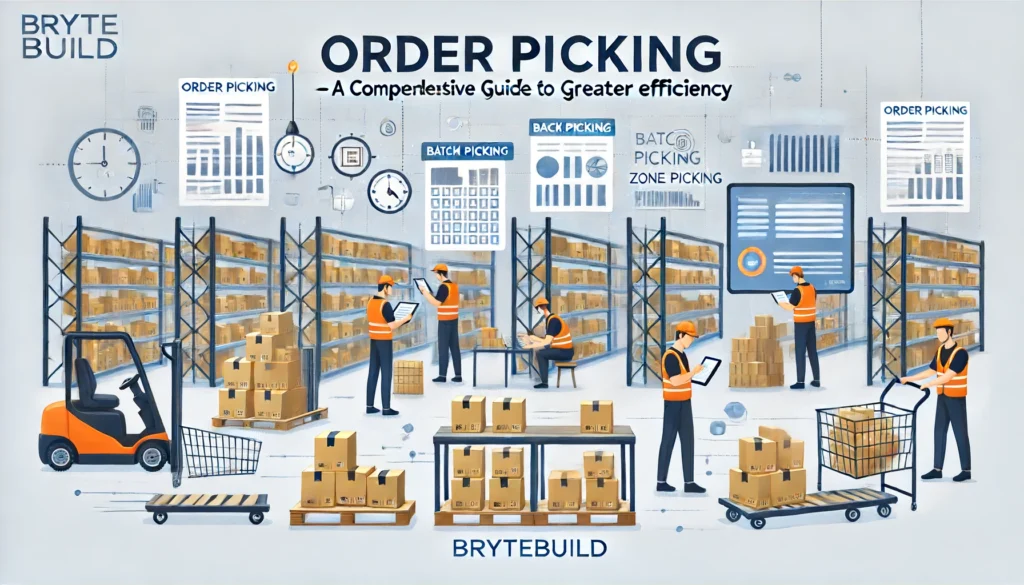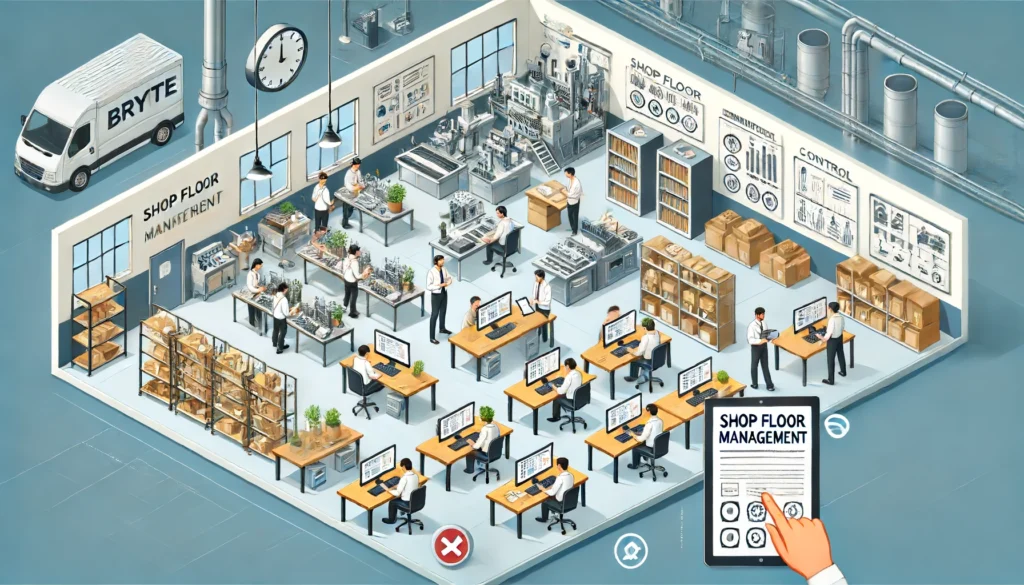Order Picking – A Comprehensive Guide to Greater Efficiency
Order picking is a fundamental process in warehouse management, essential for ensuring timely and accurate customer order fulfillment. This comprehensive guide explores various manual and automated picking methods to enhance efficiency and reduce costs, each tailored to different warehouse sizes and operational needs.
Table of Contents
- What is Order Picking?
- The Importance of Efficient Order Picking
- Manual Order Picking Methods
- Automated Order Picking Systems
- Tracking Order Picking Efficiency
- Order Picking Best Practices for Small Manufacturers and Distributors
- Enhancing Business Operations with Brytebuild
- Key Takeaways
- FAQs
What is Order Picking?
Order picking is the process of physically collecting goods from inventory to fulfill customer orders. It is a crucial part of the order fulfillment process that helps save time and reduce costs when conducted efficiently. Picking is typically assigned to warehouse workers or, in larger operations, specialized order pickers.
Warehouse order picking is equally important for e-commerce fulfillment centers, local distributors, and independent manufacturers. The chief difference lies in the volume of orders and the scale of the inventory or warehouse.
Order Picking vs. Material Handling
Order picking should not be confused with material handling. Material handling involves internal logistics processes like moving raw materials or work-in-process items to the next step in their manufacturing routing. While both involve picking items from inventory, material handling is part of the manufacturing process, whereas order picking is associated with order fulfillment—getting goods from stock ready for shipping.
The Importance of Efficient Order Picking
Efficient order picking can significantly impact order fulfillment efficiency for both manufacturers and distributors. Here are four reasons to prioritize order picking efficiency:
- Reduction in Operational Costs: Minimizing the manpower, time, and effort required to fulfill orders keeps operational costs in check. For example, efficient picking reduces the need for overtime and additional temporary workers during peak seasons.
- Improvement in Customer Satisfaction: Faster and more accurate picking means quicker fulfillment with fewer errors, enhancing customer satisfaction and encouraging repeat business. A study by the National Retail Federation found that 96% of customers are more likely to shop with a retailer again if the order fulfillment process is efficient.
- Scalability: Efficient picking practices handle increased order volumes without a proportional increase in errors or delays, essential for growth during peak demand periods or business expansion. According to Logistics Management, scalable picking processes can increase order fulfillment capacity by up to 50% without additional resources.
- Enhanced Inventory Management: Integrated with robust inventory management systems, efficient order picking helps maintain accurate inventory levels and reduces inventory errors. This integration helps in real-time tracking of inventory, reducing discrepancies and improving stock accuracy by 30% on average.
Manual Order Picking Methods
Several tried and tested order picking methods can be chosen depending on warehouse layout, operational scale, and the type of goods handled. Here are the primary manual methods:
Single Order Picking
Also known as discrete picking, this straightforward method involves one picker responsible for collecting all items for a single order at a time. This method is suitable for small-scale operations with limited SKUs and a small warehouse. A survey by Warehouse Management System Guide indicates that single order picking can achieve a 99.5% accuracy rate in small warehouses.
Batch Order Picking
Batch order picking, or multi-order picking, involves fulfilling similar or identical orders simultaneously. Pickers visit each SKU’s location once for multiple orders, saving time. This method is ideal for medium-sized operations. Research from the Journal of Business Logistics suggests that batch picking can reduce travel time by 20-30%.
Cluster Picking
Cluster picking involves picking SKUs for multiple orders at once and placing them in bins on a picking cart. Each bin represents a separate order, allowing multiple items to be picked in a single trip. This method can eliminate the need for sorting at the picking area. According to Material Handling & Logistics, cluster picking can improve picking efficiency by up to 15%.
Zone Picking
In zone picking, the warehouse is divided into zones, each assigned to specific pickers. Pickers collect items within their zones and bring them to a central area for sorting and finalizing orders. This method is popular in larger warehouses with complex orders. The ABC analysis often helps in zone picking by categorizing inventory based on turnover rates.
Pick and Pass
A combination of zone and cluster picking, pick and pass involves dividing the warehouse into zones and sorting items into bins during picking. Once items are picked in one zone, the bins are passed to the next zone, reducing sorting time. This method is particularly effective in warehouses with high SKU counts and complex order structures.
Wave Picking
Wave picking combines zone and batch picking, grouping orders based on order times and importance. Orders are picked in “waves” to optimize warehouse movements, avoid congestion, and eliminate excess labor. Studies have shown that wave picking can increase throughput by up to 30% during peak periods.
Pallet Picking, Piece Picking, and Case Picking
These terms refer to the type of items picked. Pallet picking involves moving whole pallets of goods, piece picking refers to picking individual items, and case picking involves picking entire cases of items. These methods can be combined with any of the aforementioned picking methods. Pallet picking is particularly useful for handling bulk orders, while piece picking is suited for detailed, smaller orders.
Automated Order Picking Systems
Automated order picking systems can further enhance efficiency, particularly in larger operations with high order volumes and SKU complexity. Here are some common automated systems:
Pick-to-Light
Pick-to-light systems use LED lights on racks and shelves to guide pickers to the correct locations. Integrated with barcode systems, this method boosts efficiency and reduces error rates, ideal for high-turnover environments. According to a study by Modern Materials Handling, pick-to-light systems can reduce picking errors by up to 50%.
Voice Picking
Voice picking systems use wearables or two-way radios to provide voice guidance to pickers. This hands-free method allows for efficient movement and safe handling of goods, enhancing multitasking and reducing errors. Research from Supply Chain Management Review indicates that voice picking can improve picking speed by 15-20%.
Conveyor Belt and Sorting Systems
Conveyor belt systems automate the transportation of items within the warehouse. When integrated with sorting systems, they streamline the picking process by automatically sorting items based on various criteria. These systems are cost-effective for larger operations but may not be suitable for smaller companies. According to the Institute of Supply Chain Management, conveyor systems can double the throughput in high-volume warehouses.
Scanner-Aided Picking
Scanner-based systems use barcode or RFID scanners to enhance picking accuracy. Pickers scan items as they pick them, sending real-time data to the inventory management system. This method can be integrated with ERP systems for comprehensive management. Studies have shown that scanner-aided picking can reduce picking errors by 60-70%.
Tracking Order Picking Efficiency
Tracking the efficiency of order picking is crucial for optimizing the process. Here are three key performance indicators (KPIs) to consider:
Picking Accuracy
Picking accuracy measures the error rate before shipping. It is calculated by dividing the number of correctly picked orders by the total number of orders picked.
Picking Accuracy = (Number of Error-Free Orders / Total Orders Picked) * 100
High picking accuracy is essential for maintaining customer satisfaction and reducing returns. Research by the Warehouse Education and Research Council suggests that improving picking accuracy by 1% can reduce return rates by up to 5%.
Order Picking Time or Units per Hour (UPH)
This KPI measures the average time to complete the picking process. It is calculated by dividing the total time spent on picking by the total number of orders picked.
Order Picking Time = Total Time Spent on Picking / Total Number of Orders Picked
UPH divides the number of units picked by the total time spent on picking, providing the average number of orders picked per hour. This KPI helps identify bottlenecks and improve overall efficiency.
Cost per Pick
Cost per pick calculates the average cost associated with picking each item or order. It is calculated by dividing the total cost of picking operations by the total number of picks.
Cost per Pick = Total Cost of Picking Operations / Total Number of Picks
Understanding the cost per pick helps in identifying cost-saving opportunities and improving the financial efficiency of warehouse operations. According to Logistics Management, reducing the cost per pick by 10% can lead to significant savings in large-scale operations.
Combining these metrics with other fulfillment and inventory management KPIs, like travel time and fill rate, provides a comprehensive view of picking efficiency.
Order Picking Best Practices for Small Manufacturers and Distributors
Here are five tips to boost picking efficiency and streamline warehouse management:
- Implement a Suitable Order Picking Method: Choose the right picking method based on operation size, SKU variety, and order volume. Experiment to identify the most efficient approach. For example, small operations may benefit from single order picking, while larger warehouses might find zone picking more effective.
- Track Picking Efficiency with KPIs: Monitor KPIs regularly to identify trends, pinpoint inefficiencies, and make informed decisions for continuous improvement. Regularly reviewing metrics like picking accuracy and order picking time helps in identifying areas for process enhancements.
- Optimize Warehouse Layout: Design the layout to minimize travel time and ensure popular products are easily accessible. Implement zoning or strategic picking paths. An optimized layout can reduce travel time by up to 50%, according to the Journal of Business Logistics.
- Invest in Warehouse Equipment: Use ergonomic picking carts, forklifts, and barcode scanners to enhance speed and accuracy. Invest in quality equipment to reduce manual errors. Ergonomic equipment can also reduce worker fatigue and improve overall productivity.
- Implement a Warehouse Management System (WMS): A WMS automates inventory tracking and generates optimal picking lists. Cloud-based systems provide cost-effective solutions with the benefits of automation. A WMS can improve picking efficiency by up to 40%, as per a report by Supply Chain Dive.
Enhancing Business Operations with Brytebuild
Brytebuild offers a powerful warehouse management system designed for small manufacturers and distributors. Here’s how Brytebuild can transform your business:
- Warehouse Management System: Features purchase order management, delivery orders, picking, packing, and a barcoding system with QR code scanning and printing.
- Inventory Tracking: Live stock quantity updates and QR code tracking for precise inventory management.
- 3D Warehouse Viewer: Allows you to live locate items and design your warehouse layout effectively.
- Scheduling System: Plan and assign jobs seamlessly, ensuring all maintenance and operational tasks are performed on time.
- Custom Permissions: Create groups with specific access levels, ensuring operational transparency and security.
Brytebuild also offers robust production management features, including digital work instructions that follow a step-by-step system. These guides can be associated with products or created independently, ensuring all employees have the information they need to perform their tasks efficiently.
Experience the benefits of Brytebuild’s advanced order picking and inventory management features. Contact us for a demo or sign up for a free trial to see how we can optimize your warehouse operations.
Key Takeaways
- Order Picking: A critical warehouse process for collecting goods to fulfill customer orders.
- Importance: Reduces operational costs, improves customer satisfaction, enhances scalability, and improves inventory management.
- Manual Methods: Include single order, batch, cluster, zone, pick and pass, and wave picking.
- Automated Systems: Include pick-to-light, voice picking, conveyor belts, and scanner-aided picking.
- Tracking Efficiency: Use KPIs like picking accuracy, order picking time, and cost per pick.
- Best Practices: Implement suitable picking methods, track efficiency, optimize layout, invest in equipment, and use a WMS.
FAQs
What is an order picker?
An order picker refers to a worker or specialized equipment dedicated to collecting products from storage to fulfill customer orders.
What does picking mean on an order?
Picking involves selecting and gathering specific items listed in a customer order from warehouse inventory, ensuring accurate collection before packaging and shipping.
How do different order picking methods impact ROI for SMEs?
Different methods affect ROI by balancing operational efficiency and labor costs. Single order picking minimizes errors for low volumes, while batch or cluster picking enhances ROI by reducing travel time and increasing throughput for high volumes. The chosen method should align with operational scale and order volume for maximum financial benefits.


